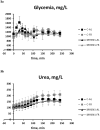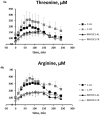Effect of feed restriction on performance and postprandial nutrient metabolism in pigs co-infected with Mycoplasma hyopneumoniae and swine influenza virus
- PMID: 25101681
- PMCID: PMC4125196
- DOI: 10.1371/journal.pone.0104605
Effect of feed restriction on performance and postprandial nutrient metabolism in pigs co-infected with Mycoplasma hyopneumoniae and swine influenza virus
Abstract
As nutritional status and inflammation are strongly connected, feeding and nutritional strategies could be effective to improve the ability of pigs to cope with disease. The aims of this study were to investigate the impact of a feed restriction on the ability of pigs to resist and be tolerant to a coinfection with Mycoplasma hyopneumoniae (Mhp) and the European H1N1 swine influenza virus, and the consequences for nutrient metabolism, with a focus on amino acids. Two groups of specific pathogen-free pigs were inoculated with Mhp and H1N1 21 days apart. One group was fed ad libitum, the other group was subjected to a two-week 40% feed restriction starting one week before H1N1 infection. The two respective mock control groups were included. Three days post-H1N1 infection, 200 g of feed was given to pigs previously fasted overnight and serial blood samples were taken over 4 hours to measure plasma nutrient concentrations. Throughout the study, clinical signs were observed and pathogens were detected in nasal swabs and lung tissues. Feed-restricted pigs presented shorter hyperthermia and a positive mean weight gain over the 3 days post-H1N1 infection whereas animals fed ad libitum lost weight. Both infection and feed restriction reduced postprandial glucose concentrations, indicating changes in glucose metabolism. Post-prandial plasma concentrations of the essential amino acids histidine, arginine and threonine were lower in co-infected pigs suggesting a greater use of those amino acids for metabolic purposes associated with the immune response. Altogether, these results indicate that modifying feeding practices could help to prepare animals to overcome an influenza infection. Connections with metabolism changes are discussed.
Conflict of interest statement
Figures




Similar articles
-
Pre-infection of pigs with Mycoplasma hyopneumoniae induces oxidative stress that influences outcomes of a subsequent infection with a swine influenza virus of H1N1 subtype.Vet Microbiol. 2013 Mar 23;162(2-4):643-651. doi: 10.1016/j.vetmic.2012.11.028. Epub 2012 Nov 29. Vet Microbiol. 2013. PMID: 23266108
-
Pre-infection of pigs with Mycoplasma hyopneumoniae modifies outcomes of infection with European swine influenza virus of H1N1, but not H1N2, subtype.Vet Microbiol. 2012 May 25;157(1-2):96-105. doi: 10.1016/j.vetmic.2011.12.027. Epub 2011 Dec 29. Vet Microbiol. 2012. PMID: 22261237 Free PMC article.
-
Experimental dual infection of pigs with an H1N1 swine influenza virus (A/Sw/Hok/2/81) and Mycoplasma hyopneumoniae.Vet Microbiol. 2004 Mar 5;98(3-4):221-8. doi: 10.1016/j.vetmic.2003.11.005. Vet Microbiol. 2004. PMID: 15036530
-
Update on Mycoplasma hyopneumoniae infections in pigs: Knowledge gaps for improved disease control.Transbound Emerg Dis. 2018 May;65 Suppl 1:110-124. doi: 10.1111/tbed.12677. Epub 2017 Aug 23. Transbound Emerg Dis. 2018. PMID: 28834294 Review.
-
Genomic Variability and Post-translational Protein Processing Enhance the Immune Evasion of Mycoplasma hyopneumoniae and Its Interaction With the Porcine Immune System.Front Immunol. 2020 Oct 7;11:510943. doi: 10.3389/fimmu.2020.510943. eCollection 2020. Front Immunol. 2020. PMID: 33117335 Free PMC article. Review.
Cited by
-
Effect of feed restriction and refeeding on performance and metabolism of European and Caribbean growing pigs in a tropical climate.Sci Rep. 2019 Mar 19;9(1):4878. doi: 10.1038/s41598-019-41145-w. Sci Rep. 2019. PMID: 30890729 Free PMC article.
-
Postprandial insulin and nutrient concentrations in lipopolysaccharide-challenged growing pigs reared in thermoneutral and high ambient temperatures1.J Anim Sci. 2019 Jul 30;97(8):3354-3368. doi: 10.1093/jas/skz204. J Anim Sci. 2019. PMID: 31250878 Free PMC article.
-
Valine and isoleucine deficiency in necrotic enteritis challenge impact growth performance, intestinal health, and muscle growth in broilers.Poult Sci. 2025 Jun;104(6):105143. doi: 10.1016/j.psj.2025.105143. Epub 2025 Apr 7. Poult Sci. 2025. PMID: 40222349 Free PMC article.
-
Selection for feed efficiency elicits different postprandial plasma metabolite profiles in response to poor hygiene of housing conditions in growing pigs.PLoS One. 2021 Mar 29;16(3):e0246216. doi: 10.1371/journal.pone.0246216. eCollection 2021. PLoS One. 2021. PMID: 33780478 Free PMC article.
-
Metabolic host response and therapeutic approaches to influenza infection.Cell Mol Biol Lett. 2020 Mar 5;25:15. doi: 10.1186/s11658-020-00211-2. eCollection 2020. Cell Mol Biol Lett. 2020. PMID: 32161622 Free PMC article. Review.
References
-
- Le Floc'h N, Melchior D, Obled C (2004) Modifications of protein and amino acid metabolism during inflammation and immune system activation. Livestock Production Science 87: 37–45.
-
- Melchior D, Sève B, Le Floc'h N (2004) Chronic lung inflammation affects plasma amino acid concentrations in pigs. Journal of Animal Science 82: 1091–1099. - PubMed
-
- Wannemacher RW Jr (1977) Key role of various individual amino acids in host response to infection. Am J Clin Nutr 30: 1269–1280. - PubMed
-
- Reeds PJ, Jahoor F (2001) The amino acid requirements of disease. Clinical Nutrition 20, Supplement 1: 15–22.
-
- Obled C (2002) Amino acid requirements in inflammatory states. Can J Anim Sci 82: 55–66.
Publication types
MeSH terms
LinkOut - more resources
Full Text Sources
Other Literature Sources
Research Materials

